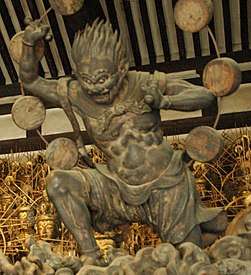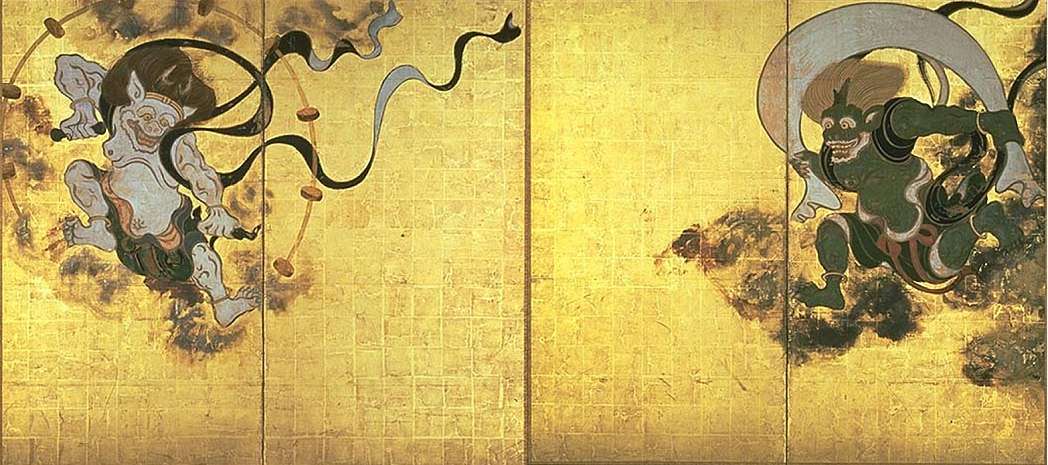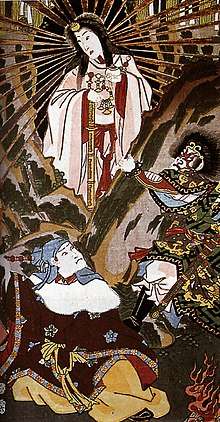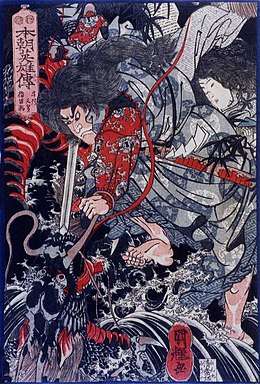Raijin
Raijin (雷神), also known as Kaminari-sama (雷様), Raiden-sama (雷電様), Narukami (鳴る神) and Raikou (雷公), is a god of lightning, thunder and storms in Japanese mythology and the Shinto religion. The name 'Raijin' is derived from the Japanese words kaminari (雷, meaning "thunder"; on-reading rai) and kami (神, meaning "god"; on-reading shin or jin). Raijin is typically depicted with fierce and aggressive facial expressions, standing atop a cloud, and is shown beating on drums. The drums are often shown to have the symbol tomoe drawn on them. Raijin is often depicted as a protector or warrior figure within Japanese temples and shrines.

Description

Raijin is often depicted with a fierce, frightening face and a muscular figure with gravity-defying hair. He is surrounded by Taiko drums that he plays to create the sound of thunder. Raijin holds large hammers in his hands that he uses to play the drums. In some cases, Raijin is portrayed with three fingers which are said to represent the past, present and future. Two of the most notable sculptures of Raijin are located in the Sanjusangendo temple and the Taiyuin Rinnoji temple.
Raijin and Fujin reside side by side in the Kaminarimon gate that guards the entrance to the Sanjusangendo temple. These sculptures are made of wood with lacquer, gold leaf and paint along with crystal, inlaid eyes. The Raijin and Fujin sculptures in Sanjusangendo are considered national treasures.
In the Taiyuin Rinnoji temple, Raijin and Fujin are located in the Niten-mon gate. They are made of wood with paint and are seen with their token talismans, Raijin's drums and Fujin's wind bag.[1]
Mythology
In the myths recorded in the Kojiki, after Izanami died from the wounds inflicted on her by the birthing of Hinokagutsutchi, her husband Izanagi followed her down into Yomi no Kuni, the land of darkness. When he asked to come with him, Izanami responded that she cannot leave, because she had already eaten from the food there. As Izanagi followed her all the way to Yomi, to try to fulfill his wish that she go with him, Izanami returned to her palace to negotiate with the residing kami. Izanami was gone for several hours, which made Izanagi worried for her. Thus, after making fire on the tip of his comb, he entered the palace.
There, Izanagi found Izanami's corpse. On her body maggots gathered, and on her head arose Great Raijin (大雷神), on her chest Fire Raijin (火雷神), in her stomach Black Raijin (黒雷神), on her vagina Blossoming Raijin (咲雷神), in her left hand Young Raijin (若雷神), in her right hand Soil Raijin (土雷神), on her left leg Roaring Raijin (鳴雷神) and on her right leg Bending Raijin (伏雷神); collectively called Ho-no-Ikadzuchi-no-Kami (火雷大神).
Upon seeing Izanami's twisted body, Izanagi fled from Yomi, shaken and in terror. In shame of allowing him to see her unsightly form, Izanami sent Raijin and several female demons to chase after Izanagi, after he fled the image of her rotting form, to bring him back to Yomi.[2]
Raijin has many siblings, most notably, Fujin (the god of wind), Kagutsuchi (the god of fire), Susanoo (the god of the sea and storms), and Amaterasu (the goddess of the sun). Raijin is also often seen in the company of his brother, Fujin, and his son, Raitaro.[3] He is often seen fighting with Fujin, mending his drums, or causing mischief. He is also shown in the company of Raiju, a thunder-beast or thunder demon.
Prayers to Raijin were mainly based upon agriculture as it was believed that rice that was struck by lightning would produce the best harvest.
Legends
In one legend, Raijin is shown to defend Japan against the invading Mongols. In this legend, the Mongols are driven off by a vicious storm in which Raijin is in the clouds throwing lightning and arrows at the invaders.[3]
Another legend depicts how a man named Sugaru (nicknamed the God-catcher) was ordered to catch the Thunder God Raijin and deliver him to the Emperor in order to stop a storm. Sugaru commands Raijin to cease the storm in the name of the Emperor but to no avail. Sugaru prayed to Kannon who later delivered Raijin to him. Sugaru then tied him up in a sack and took him to the Emperor.[3]
Modern role
Some Japanese parents tell their children to hide their belly buttons during thunderstorms so that Raijin does not take them away and eat them.
Raijin also appears in the kabuki play Narukami, in which he is imprisoned under a pool of water, thus causing a drought.[4]
See also
- Fūjin (Japanese), god of wind
- Izanagi (Japanese), one of the divine pair of creation deities
- Izanami (Japanese), one of the divine pair of creation deities
- Leigong (Chinese), god of thunder
- Leizi (Chinese), goddess of lightning
- Parjanya (Hindu), god of rain, thunder and lightning
- Raiden (Mortal Kombat)
- Sanjūsangen-dō (Japanese temple)
References
- Pier, Garrett Chatfield (1914). Temple Treasures of Japan. F.F. Sherman.
- "THE KOJ-IKI". www.sacred-texts.com. Retrieved 2019-03-29.
- Joly, Henri L. (1908). Legend in Japanese Art: A Description of Historical Episodes, Legendary Characters, Folk-lore, Myths, Religious Symbolism, Illustrated in the Arts of Old Japan. John Lane.
- "May at the Kabukiza Theatre|Theatres". KABUKI WEB. Retrieved 2019-04-07.
External links
| Wikimedia Commons has media related to Thunder deities. |
- Netsuke: masterpieces from the Metropolitan Museum of Art, an exhibition catalog from The Metropolitan Museum of Art (fully available online as PDF), which contains many representations of Raijin

